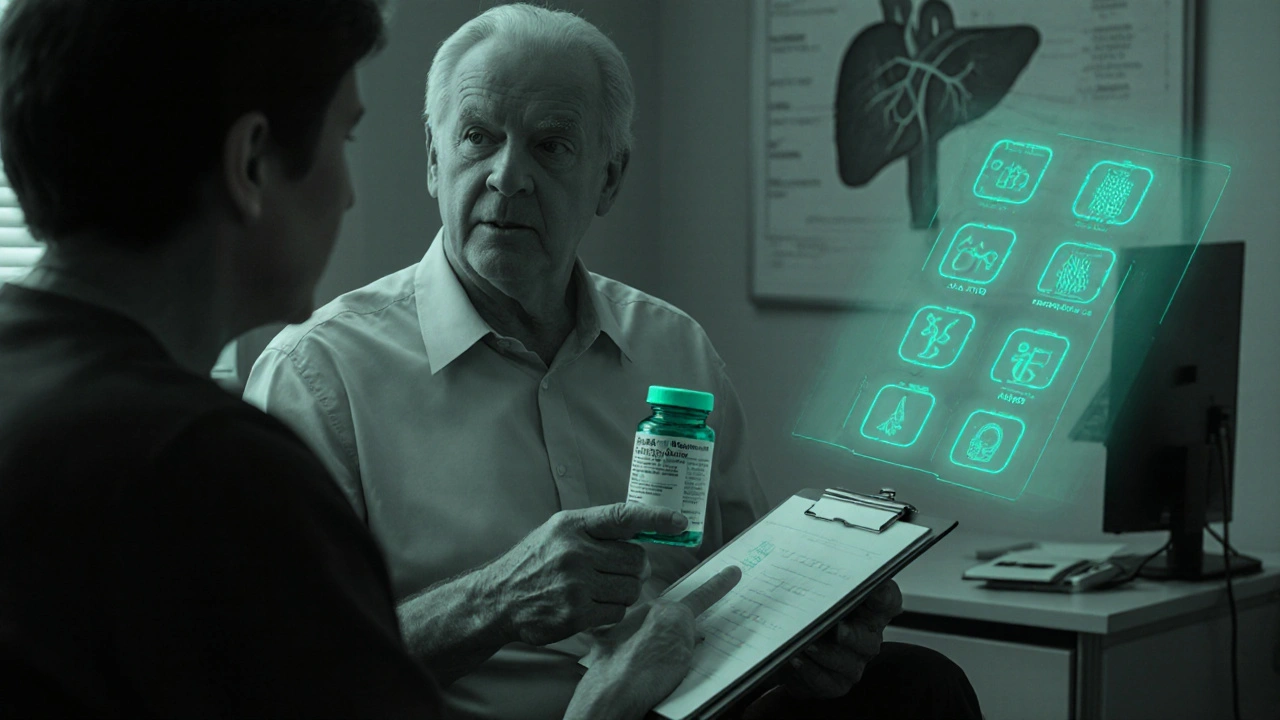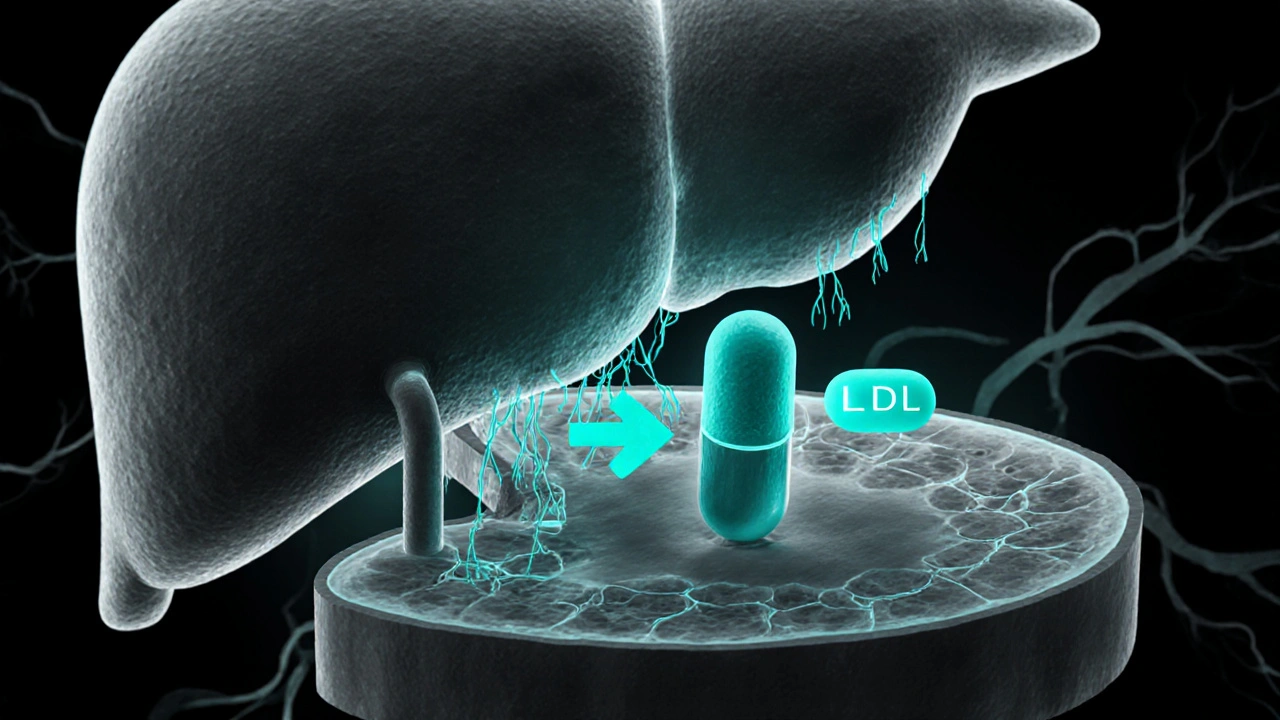Atorvastatin & Vitamin B6 Safety Checker
Medication Safety Assessment
Check if your atorvastatin and vitamin B6 combination is within safe limits based on medical guidelines.
Key Takeaways
- Atorvastatin is a statin that lowers LDL cholesterol by blocking HMG‑CoA reductase.
- Vitamin B6 (pyridoxine) supports nerve function and metabolism, but high doses may affect drug metabolism.
- Current research shows no strong evidence of a harmful interaction, yet monitoring is advised.
- Take supplements at least2hours apart from atorvastatin to minimise any theoretical absorption issues.
- Watch for muscle aches, liver‑function changes, or unusual fatigue, and report them to your clinician.
How Atorvastatin Lowers Cholesterol
When it comes to lowering bad cholesterol, Atorvastatin is a prescription medication that belongs to the statin class and works by inhibiting the enzyme HMG‑CoA reductase, a key step in cholesterol synthesis. By reducing the liver’s production of low‑density lipoprotein (LDL), it cuts the risk of heart attacks, strokes, and peripheral artery disease. Most patients start with 10‑20mg daily, but doctors may increase to 80mg for high‑risk cases.
What Vitamin B6 Does in the Body
Vitamin B6 (pyridoxine) acts as a co‑enzyme in over 100 chemical reactions, from amino‑acid metabolism to neurotransmitter synthesis. It helps maintain healthy nerves, supports immune function, and assists the conversion of tryptophan to serotonin. Dietary sources include bananas, chickpeas, and fortified cereals. Typical supplemental doses range from 10mg to 100mg daily, but the tolerable upper intake level for adults is 100mg to avoid neuropathy.

Potential Interaction Mechanisms
So, do atorvastatin vitamin b6 interactions matter? The short answer: not dramatically, but some biochemical pathways warrant attention.
- CYP3A4 - Atorvastatin is metabolised mainly by the liver enzyme CYP3A4. Vitamin B6 can modestly induce certain cytochrome‑P450 enzymes, potentially speeding up atorvastatin clearance, which might lower its efficacy.
- Liver enzymes - Both agents are processed in the liver. High‑dose B6 has been linked to modest elevations in ALT/AST, though evidence is sparse. If you already have borderline liver values, adding a supplement could push them higher.
- Muscle pain (myopathy) - Statins can cause muscle aches in up to 10% of users. Vitamin B6 deficiency is also associated with neuropathy, but excess B6 can paradoxically cause peripheral nerve damage, which might be confused with statin‑related myopathy.
Overall, most clinical trials report no significant adverse outcomes when normal dietary B6 levels or modest supplements are taken alongside atorvastatin. The concern mainly arises with very high B6 doses (>200mg) or when other CYP3A4‑inhibiting drugs are part of the regimen.
When to Take Vitamin B6 with Atorvastatin
Timing can reduce any theoretical competition for absorption. Here’s a practical schedule:
- Take atorvastatin **in the evening** with or without a light snack. Food slightly improves bioavailability, but a heavy fatty meal may increase side‑effects.
- Consume your vitamin B6 **at least 2 hours later** - for example, a mid‑morning or early afternoon dose.
- If you split the statin dose (rare), keep the B6 supplement on the opposite side of the day.
Adhering to this spacing helps ensure each compound is absorbed under optimal conditions while keeping liver load manageable.
Dosage Guidelines and Safety Tips
Below is a quick reference for typical dosing ranges. Adjustments should always be made by a healthcare professional.
| Aspect | Typical Range | Clinical Note |
|---|---|---|
| Atorvastatin dose | 10-80mg per day | Start low, titrate based on LDL response and tolerance. |
| Vitamin B6 supplement | 10-100mg per day | Stay below 100mg to avoid neuropathy; higher only under medical supervision. |
| Timing interval | ≥2hours apart | Reduces competition for intestinal transporters and liver metabolism. |
| Monitoring labs | Liver enzymes (ALT/AST) every 3‑6months; CK if muscle symptoms appear | Early detection of rare side‑effects. |
Key safety pointers:
- Report any new or worsening muscle pain, especially if it’s accompanied by dark urine.
- Ask your doctor for a baseline liver‑function panel before starting a supplement.
- If you’re on other CYP3A4‑affecting drugs (e.g., clarithromycin, grapefruit juice), discuss supplement timing with your pharmacist.
- Pregnant or nursing women should avoid high‑dose B6 without medical advice.

Special Populations
Older adults often take multiple medications, raising the risk of drug‑nutrient interactions. A study of patients over 65 showed that adding a 50mg B6 supplement to statin therapy did not change LDL levels but slightly increased reports of mild tingling, which resolved after lowering B6 to 25mg.
People with chronic kidney disease may have altered B6 metabolism, so clinicians usually aim for the lower end of the supplement range.
Bottom Line: Do You Need to Change Anything?
If you’re already on atorvastatin and consider a vitamin B6 supplement for mood or nerve health, the evidence says you’re generally safe as long as you stay within recommended doses and keep an eye on how you feel. No major drug‑drug interaction has been proven, but personal variables-like other meds, liver health, and supplement dose-can shift the balance.
Always discuss new supplements with your GP or cardiologist. A quick blood test can confirm that liver enzymes and CK (creatine kinase) remain in the normal range.
Frequently Asked Questions
Can vitamin B6 reduce the cholesterol‑lowering effect of atorvastatin?
There is no strong clinical evidence that normal‑dose B6 weakens atorvastatin’s impact. Very high B6 might speed up the drug’s breakdown, but this is rare and usually only seen with doses above 200mg.
Should I take my B6 supplement at the same time as my statin?
It’s best to separate them by at least two hours. This spacing helps avoid any competition for absorption and gives the liver a chance to process each compound separately.
What muscle‑related symptoms should make me call my doctor?
Any unexplained muscle soreness, weakness, or cramping that lasts more than a few days, especially if it’s paired with dark‑colored urine, warrants a check‑up. Your doctor may measure CK levels to rule out statin‑associated myopathy.
Is it safe to combine atorvastatin with a multivitamin that contains B6?
Yes, as long as the B6 amount stays under 100mg per day, which most multivitamins do. Keep an eye on any new symptoms and discuss with your healthcare provider.
Do I need regular blood tests when I start a B6 supplement?
Baseline liver‑function tests are wise before adding any new supplement, especially if you’re on a statin. Follow‑up testing every 3‑6months is standard practice for monitoring potential side‑effects.

15 Responses
Your article is a waste of time.
While I respect the effort put into the piece, I must point out several factual inaccuracies. The recommendation to separate atorvastatin and vitamin B6 by exactly two hours lacks robust clinical evidence. Moreover, the tone of the article seems overly casual for a medical discussion. I encourage the author to consult peer‑reviewed sources to strengthen the claims.
When you look at the biochemical pathway of atorvastatin you see that it primarily blocks HMG‑CoA reductase in the liver. This action reduces the synthesis of cholesterol and lowers LDL levels in the bloodstream. Vitamin B6, on the other hand, serves as a co‑enzyme in over one hundred enzymatic reactions. It is involved in amino acid metabolism and neurotransmitter synthesis. The two substances are processed by different mechanisms in the body. Atorvastatin is metabolised mainly by the CYP3A4 enzyme. Vitamin B6 can mildly induce certain cytochrome enzymes but the effect is modest. Most clinical trials have not shown a significant interaction between standard doses of B6 and atorvastatin. However, high‑dose B6 (>200 mg) may increase hepatic enzyme activity. This could theoretically reduce the plasma concentration of atorvastatin. In practice, the reduction is usually not enough to impact therapeutic outcomes. Patients should still monitor their lipid panels after starting any new supplement. If a patient experiences unexplained muscle pain they should have their creatine kinase measured. Liver function tests remain a prudent part of routine monitoring for anyone on statins. The timing recommendation of a two‑hour gap is based on theoretical absorption considerations rather than strong evidence. Overall, the combination is considered safe for most individuals when doses stay within recommended limits.
Honestly the article sounds like it was written by a clueless copy‑paster. Who even believes a two‑hour rule is gospel? You can do better than spouting half‑baked advice.
Greetings fellow readers. I would like to add that age and renal function can modify how both atorvastatin and vitamin B6 are handled by the body. In older adults the clearance of statins may be reduced, so lower doses are often advisable. Likewise, patients with chronic kidney disease may benefit from staying at the lower end of the B6 supplement range. It is always wise to discuss any new supplement with a healthcare professional before starting. Monitoring liver enzymes and muscle enzymes periodically can catch rare adverse events early.
From a coaching perspective, consistency is key when taking any medication or supplement. Establish a routine that separates your statin dose from your B6 intake by a few hours. This mental cue can help you avoid accidental stacking. Remember also to pair your statin with a light evening snack to improve absorption without overloading your stomach.
Drama alert: if you ignore the timing advice you might end up with a nightmare of muscle cramps and nerve tingling. Stop being lazy and follow the schedule!
Hey folks, great vibes on this thread! I’ve been on atorvastatin for years and add a modest B6 supplement without any drama. Just keep an eye on how you feel and you’ll be golden. Cheers!
Cool info, but double‑check the dosage ranges – 10‑100 mg B6 is the sweet spot. :)
Philosophically speaking, the interplay of drugs and vitamins mirrors the balance of mind and body. One must not treat supplements as mere afterthoughts. Respect the science, respect your health.
I appreciate the thoroughness of the article but would suggest a clearer layout for the timing recommendations. A simple bullet list could make the two‑hour rule stand out. Also, adding a short disclaimer about individual variability would be prudent. In collaborative environments, sharing personal experiences can enrich the discussion. Let’s keep the conversation constructive.
Stay motivated! Keep your cholesterol in check and your nerves happy with the right dose. Consistency wins.
I’m curious about the clinical evidence behind the two‑hour separation. Does anyone have a study link? Also, are there known cases where B6 actually reduced statin efficacy? Thanks for the insights.
Allow me to correct a few misconceptions: First, the upper tolerable intake level for vitamin B6 is firmly set at 100 mg per day, not 200 mg as some sources mistakenly claim; second, the majority of peer‑reviewed pharmacokinetic studies demonstrate only a negligible effect of standard‑dose B6 on CYP3A4 activity; third, any recommendation to separate doses by exactly two hours should be presented as a precautionary suggestion rather than an absolute rule. I trust these clarifications will enhance the article’s accuracy.
Interesting perspective, however, one might argue, with all due respect, that the article oversimplifies a complex pharmacological interaction, and, consequently, readers should remain skeptical, especially when the evidence is not unequivocal.